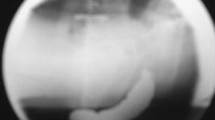Abstract
The management of rectal internal mucosal prolapse (RIMP) is not based on an accepted classification of the lesion which helps to choose the appropriate treatment. The aim of this prospective study was to report a new endoscopic grading of RIMP and to evaluate its clinical value. Thirty-two patients (7 men, 25 women; mean age 56 years, range 28–72) affected by symptomatic RIMP were prospectively classified as follows: RIMP was defined as first degree when detectable below the anorectal ring on straining, as second degree when it reached the dentate line, and as third degree when it reached the anal verge. Anal manometry was carried out in 26 patients, and anal ultrasound and defecography in 6 prior to surgery. A correlation was found between the occurrence and severity of symptoms and the degree of the prolapse as obstructed defecation, bleeding and fecal soiling affected mainly patients with third-degree RIMP. At manometry the maximal resting tone was 60±23 mmHg and voluntary contraction 96±41 mmHg (mean±SEM). At anal ultrasound the mean internal sphincter thickness was 2.1±0.2 mm, and external sphincter thickness was 7.0±0.8 mm. A significant rectocele and rectal intussusception (n=2) and a nonrelaxing puborectalis muscle on straining (n=2) were observed at defecography in cases with third-degree RIMP. The anorectal angle was 100±75° at rest, 63±20° on squeezing, and 115±9° on straining. A conservative treatment with high-fiber diet and/or rubber band ligation was carried out in all cases of first and in most patients with second-degree RIMP (n=26). Those who required surgery, i.e., stapled transanal excision of the prolapse (n=6), had either severely symptomatic third-degree RIMP with solitary ulcer syndrome (n=4) or second-degree RIMP (n=2). A positive outcome was achieved in 71% of cases. The proposed classification evaluated by the present study may be of clinical value in managing rectal internal mucosal prolapse.
Similar content being viewed by others
Author information
Authors and Affiliations
Additional information
Accepted: 18 June 1999
Rights and permissions
About this article
Cite this article
Pescatori, M., Quondamcarlo, C. A new grading of rectal internal mucosal prolapse and its correlation with diagnosis and treatment. Int J Colorect Dis 14, 245–249 (1999). https://doi.org/10.1007/s003840050218
Issue Date:
DOI: https://doi.org/10.1007/s003840050218




